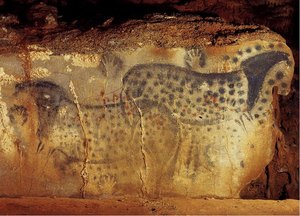
Pareidolie Paléolithique?
(In English below)
On observe une constante étonnante dans l'art préhistorique qui se manifeste par l'utilisation de formes naturelles d'un support pour en faire surgir la morphologie d'un animal.
Ce procédé aux origines de l' Art répond au joli nom de Paréidolie. C'est la faculté de pouvoir voir un visage dans les nuages par exemple, ce que les enfants connaissent bien.
Il s'agit d'une tendance naturelle à donner du sens à des choses abstraites et à les identifier à des choses concrètes. Elle nous permet de reconnaître des formes connues dans des images aussi désordonnées que les constellations, ce qui nous permet de rendre le monde intelligible et communicable.

Comprendre que l'identification se fait par ressemblance à des formes familières répertoriées en mémoire et que notre interprétation se fait par projection nous mène à prendre conscience que notre perception du monde est une (re)construction permanente, oscillant entre mémoire et imagination.
L'art paléolithique s'est souvent nourri de cette propention à appréhender les choses de façon métaphorique et l'a utilisé dans ses représentations, faisant ainsi naître une première forme de poésie.
Au fond de ces cavités naturelles à l'apparence organique, les artistes du paléolithique repèraient alors des parties de paroi dont le relief faisait apparaître des formes qui rappelaient l'anatomie d'animaux qu'ils observaient en cette période glaciaire, mammouths, rhinocéros laineux, lions, chevaux, bisons, mégacéros et même pingouins...Ils partaient alors d'une fissure qui évoquait le revers d'une patte, une bosse suggérant le dos ou un caillou pris dans la roche calcaire pour signifier un oeil, puis traçaient ensuite le contour de l'animal dans un style épuré, utilisant l'oxyde de fer ou de manganèse avec parcimonie en ne dessinant que les éléments que le relief ne faisait pas apparaître; il s'en dégageait alors une silhouette symbolique caractéristique et identifiable par tous.
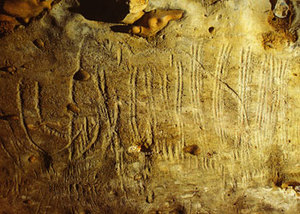
Cette approche permettait d'apporter en plus du trait le volume et rendaient ces représentations plus suggestives et vivantes, surtout sous la lumière vacillante des lampes à graisse, au coeur de la Terre Mère où peut-être leurs légendes ont fait apparaître les premiers êtres.
Ces premiers individus modernes qui se distinguent par les premières formes de création semblent de fait avoir rendu un culte à la force créatrice de la Nature à travers la représentation de grands animaux - qu'ils ne chassaient pas - laissant la représentation de l'homme en arrière-plan, simple observateur contemplatif fasciné par son environnement.
Cette constante dans l'art pariétal et mobilier est d'autant plus étonnante qu'elle couvre toute la période paléolithique, des Aurignaciens de la grotte Chauvet-Pont d'Arc il y a 36000 ans, en passant par les Gravettiens de la grotte du Pech Merle il y a 24000 ans, jusqu'aux Magdaléniens de Lascaux il y a 18000 ans et ceux de Niaux il y a 13000 ans...
Des sculptures d'une incroyable dextérité retrouvées un peu partout dans le sud de la France comme au Mas d'Azil par exemple, visibles à la salle Piette du Musée d'Archéologie Nationale de Saint-Germain-en-Laye, à celles extraordinaires du Jura Souabe ou de République Tchéque, permettent de se rendre compte qu'ils travaillaient avec la même approche des matériaux aussi différents que l'os, le bois de renne, l'ivoire de mammouth, dent de cachalot...
Malheureusement les objets en bois, certainement plus répandus mais périssables ne sont pas parvenus jusqu'à nous...
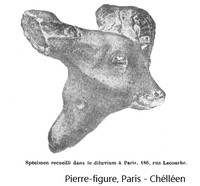
ARCHE-O
Du Grec ancien ARKHO "Commencement", l'arché est la question de l'origine première, qui est un principe fondamental de la philosophie antique auquel se rattache un principe originaire commun.
C'est dans cet esprit de comprendre certains processus de l'art des origines que j'ai approfondi cette démarche, expérimentation technique et philosophique entre art et archéologie.
ANGE
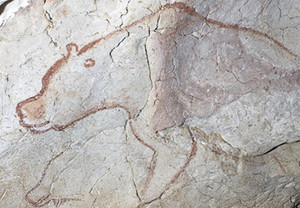
Paleolithic Pareidolia?
Prehistoric Art is characterized by the use of natural shape and morphology of an item (i.e. rock, stone, wood, etc.) to craft different kind of animals.
This process, which is at the origins of Art, is called Pareidolia. For instance, Pareidolia is the ability to visualize a face in the clouds, like kids often do.
It is a common behaviour to assign meaning to abstract things and to relate them with meaningful things. It allows us to recognize known forms in constellations, and therefore make the world more intelligible and communicable.
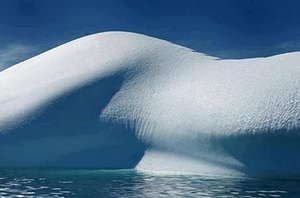
This process of identification starts with a resemblance to familiar forms listed in our memory, and our interpretation achieved done by projection. This leads us to realize that our perception of the world is a permanent (re)construction at the intersection of memory and imagination.
In this context, Paleolithic art has often used metaphors, thus creating a first form of poetry.
In the depth of these natural cavities, the artists of the Paleolithic era used the natural shape of the walls which exhibited a reminiscent shape of animals they observed in their everyday life such as mammoths, wooly rhinoceros, lions, horses, bisons, megaceros and penguins. They eventually carved a crack that evoked a paw, a hump suggesting the back, or a pebble caught in the limestone referring to an eye. Then, the outline of the animal were drawn in a minimalist way, using iron oxide or manganese, bringing light to a symbolic silhouette identifiable by all.
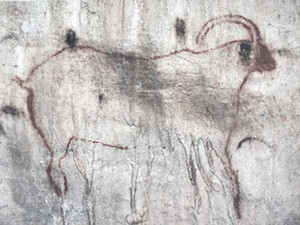
This approach, combining line and volume, was more suggestive and lively, especially under the flickering light of the grease lamps, in the heart of the Mother Earth, where perhaps their legends revealed the first beings.
These first modern individuals, which are characterized by the first identified forms of creation and artwork to date, seemed to have made a cult of the creative force of nature by focusing onlarge animals (which they did not hunt) and therefore by leaving the representation of Humans in the background..
This type of wall and furniture art covered the entire Paleolithic period, from the Aurignacians of the Chauvet Cave - Pont d'Arc 36000 years ago, the Gravettians of the cave of the Pech Merle 24000 years ago, as well as Magdalenian of Lascaux 18000 years ago and Magdalenian of Niaux 13000 years ago.
Fine Sculptures have been found everywhere in the south of France such as in the Mas Azil, currently displayed at the French National Museum of Archaeology of Saint-Germain-en-Laye, along with the extraordinary Swabian Jura or Czech Republic Paleolithic artwork, all sharing the same artistic form by using bone, reindeer wood, mammoth ivory, Sperm whale's tooth. In it worth mentioning that wooden artwork, which might have been even more common, but has not travel through the ages.
ARCHE-O
From the ancient Greek ARKHO "beginning", "Arche" is the question of the first Origin, which is the “first principle” of ancient philosophy to which a common original principle is attached.
This in mind, my art is a tribute to this ancient art, by using a technical and philosophical experimentation between art and archaeology.
ANGE
